 Database
Database
 Mysql Tutorial
Mysql Tutorial
 How to solve the problem of configuring mysql database user permissions in Navicat
How to solve the problem of configuring mysql database user permissions in Navicat
How to solve the problem of configuring mysql database user permissions in Navicat
When using a database, you will encounter multiple users and assign user permissions. Some users can only read, some users can read and write, and some users can only operate. For one or more databases, how to set permissions for mysql users? Here I will describe how to use navicat graphical operations to assign user permissions
If you use sql grant to assign permissions, refer to MYSQL database management Permission management
Basic sql grant command:
Assign a user all permissions to a single database: grant all on database name.* to user name@ ’%’ identified by ‘password’;
Query database user permissions: show grants for username@’%’;
1. Create a user
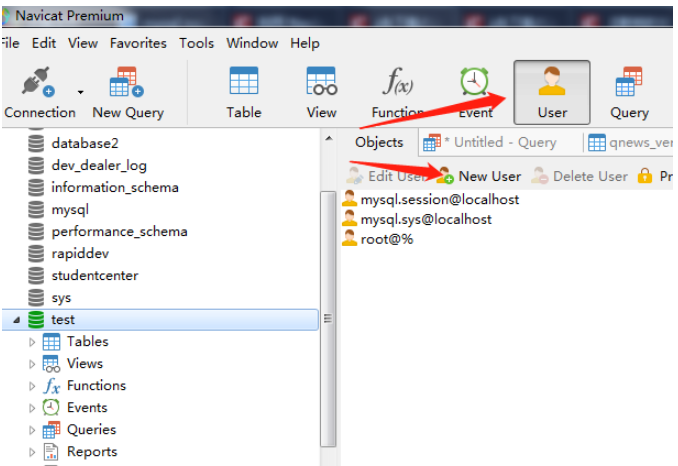
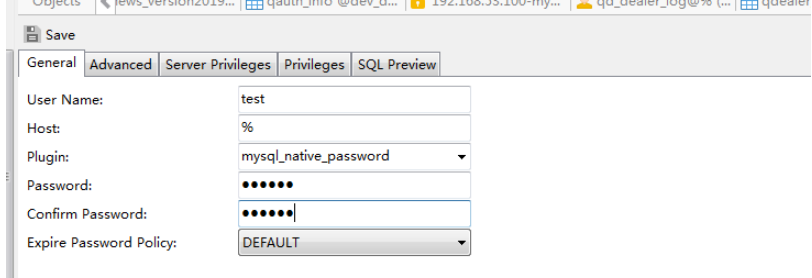
Note: The Host configuration is %, which means all IPs can access
2. Assign permissions to the newly created user
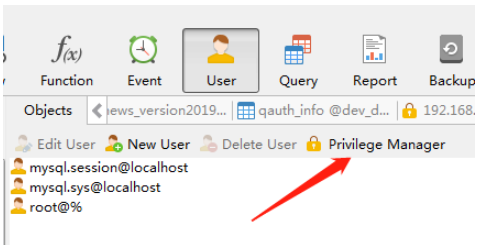
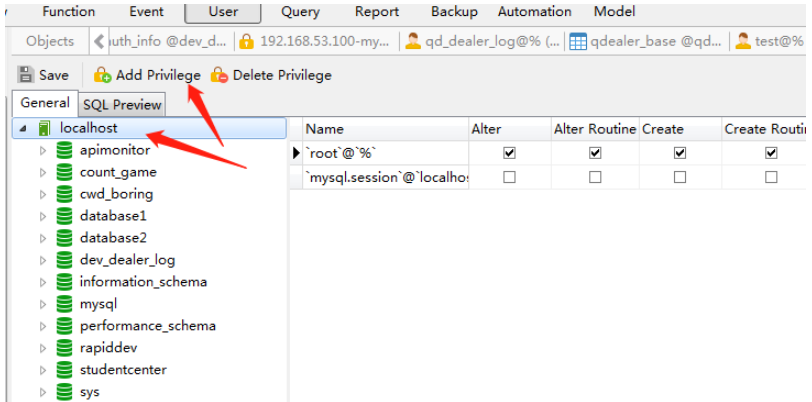
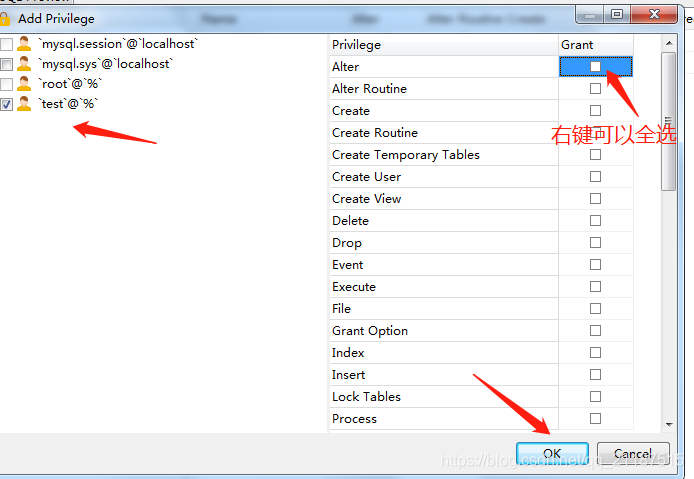
##Key points:
- Adding permissions to the top localhost is valid for all databases
- Select a single database and click Add permissions, it is valid for all databases The selected database is valid
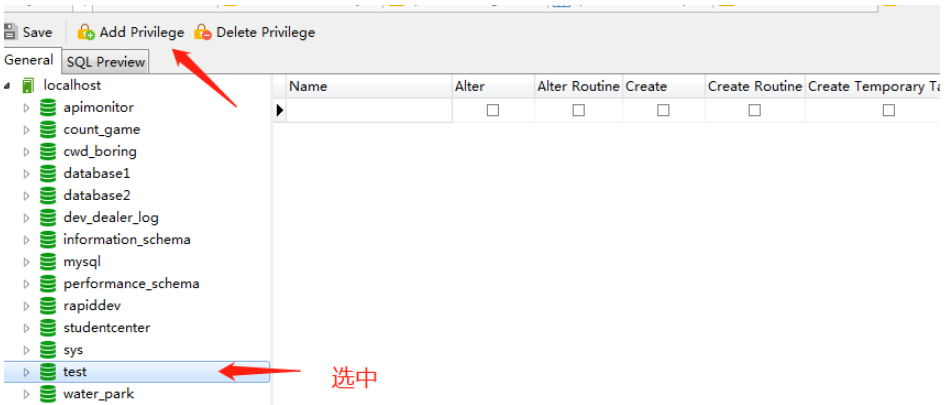
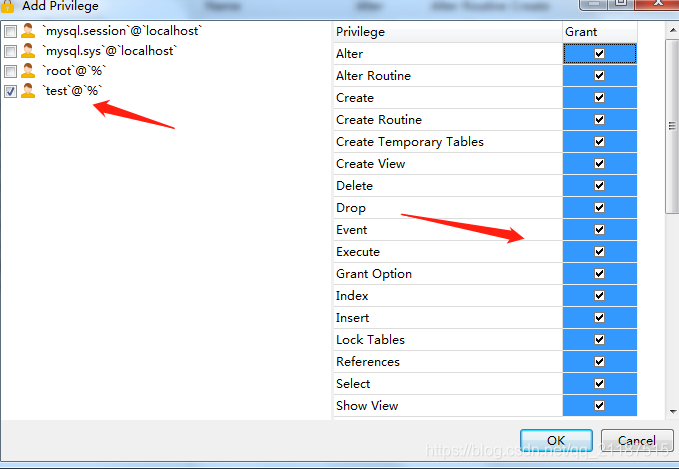
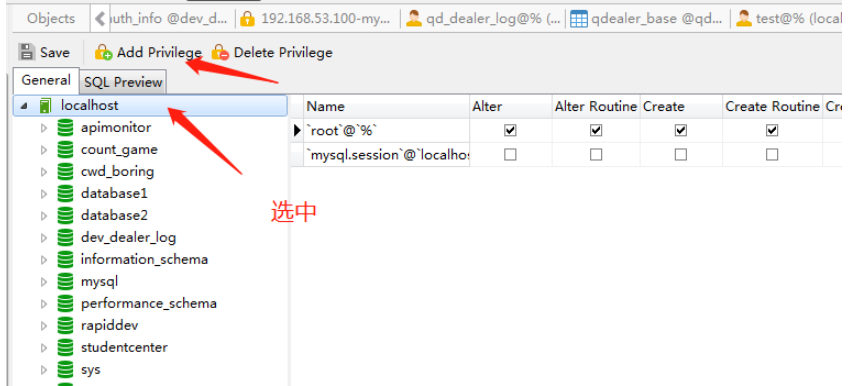
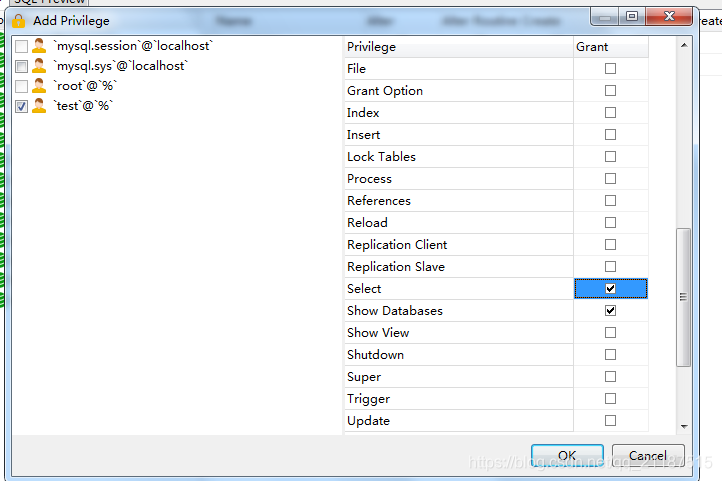
| Permissions | Permission Level | Permissions Description |
| CREATE | Database, table or index | Create Database, table or index permissions |
| DROP | ##Database or tableDelete database or table permissions | |
| Database, table or saved program | Grant permission options | |
| Database or table | ||
| Table | ALTER TABLE , such as adding fields, indexes, etc. | |
| Table | Delete data permissions | |
| Table | Index permissions | |
| Table | INSERT PERMISSION | |
| Table | Query Permission | |
| Table | Update Permission | |
| View | Create View Permission | |
| View | View view permission | ##ALTER ROUTINE |
Stored Procedure |
Change Stored Procedure Permissions |
CREATE ROUTINE |
Stored Procedure |
Create Stored Procedure Permission |
EXECUTE |
Stored Procedure |
Execute Stored Procedure Permission |
FILE |
File access on the server host |
File access permissions |
CREATE TEMPORARY TABLES |
Server Management |
Create Temporary Table Permission |
LOCK TABLES |
Server Management |
Lock table permissions |
CREATE USER |
Server Management |
Create User Permissions |
PROCESS |
Server Management |
View process permissions |
RELOAD |
Server Management |
Permission to execute flush-hosts, flush-logs, flush-privileges, flush-status, flush-tables, flush-threads, refresh, reload and other commands |
|
REPLICATION CLIENT |
Server Management |
Copy Permission |
REPLICATION SLAVE |
Server Management |
Replication Permission |
SHOW DATABASES |
Server Management |
View database permissions |
SHUTDOWN |
Server Management |
Close database permissions |
SUPER |
Server Management |
Execute kill thread permission |
The above is the detailed content of How to solve the problem of configuring mysql database user permissions in Navicat. For more information, please follow other related articles on the PHP Chinese website!

Hot AI Tools

Undresser.AI Undress
AI-powered app for creating realistic nude photos

AI Clothes Remover
Online AI tool for removing clothes from photos.

Undress AI Tool
Undress images for free

Clothoff.io
AI clothes remover

Video Face Swap
Swap faces in any video effortlessly with our completely free AI face swap tool!

Hot Article

Hot Tools

Notepad++7.3.1
Easy-to-use and free code editor

SublimeText3 Chinese version
Chinese version, very easy to use

Zend Studio 13.0.1
Powerful PHP integrated development environment

Dreamweaver CS6
Visual web development tools

SublimeText3 Mac version
God-level code editing software (SublimeText3)

Hot Topics
 1665
1665
 14
14
 1423
1423
 52
52
 1321
1321
 25
25
 1269
1269
 29
29
 1249
1249
 24
24
 MySQL and phpMyAdmin: Core Features and Functions
Apr 22, 2025 am 12:12 AM
MySQL and phpMyAdmin: Core Features and Functions
Apr 22, 2025 am 12:12 AM
MySQL and phpMyAdmin are powerful database management tools. 1) MySQL is used to create databases and tables, and to execute DML and SQL queries. 2) phpMyAdmin provides an intuitive interface for database management, table structure management, data operations and user permission management.
 MySQL vs. Other Programming Languages: A Comparison
Apr 19, 2025 am 12:22 AM
MySQL vs. Other Programming Languages: A Comparison
Apr 19, 2025 am 12:22 AM
Compared with other programming languages, MySQL is mainly used to store and manage data, while other languages such as Python, Java, and C are used for logical processing and application development. MySQL is known for its high performance, scalability and cross-platform support, suitable for data management needs, while other languages have advantages in their respective fields such as data analytics, enterprise applications, and system programming.
 Explain the purpose of foreign keys in MySQL.
Apr 25, 2025 am 12:17 AM
Explain the purpose of foreign keys in MySQL.
Apr 25, 2025 am 12:17 AM
In MySQL, the function of foreign keys is to establish the relationship between tables and ensure the consistency and integrity of the data. Foreign keys maintain the effectiveness of data through reference integrity checks and cascading operations. Pay attention to performance optimization and avoid common errors when using them.
 Compare and contrast MySQL and MariaDB.
Apr 26, 2025 am 12:08 AM
Compare and contrast MySQL and MariaDB.
Apr 26, 2025 am 12:08 AM
The main difference between MySQL and MariaDB is performance, functionality and license: 1. MySQL is developed by Oracle, and MariaDB is its fork. 2. MariaDB may perform better in high load environments. 3.MariaDB provides more storage engines and functions. 4.MySQL adopts a dual license, and MariaDB is completely open source. The existing infrastructure, performance requirements, functional requirements and license costs should be taken into account when choosing.
 SQL vs. MySQL: Clarifying the Relationship Between the Two
Apr 24, 2025 am 12:02 AM
SQL vs. MySQL: Clarifying the Relationship Between the Two
Apr 24, 2025 am 12:02 AM
SQL is a standard language for managing relational databases, while MySQL is a database management system that uses SQL. SQL defines ways to interact with a database, including CRUD operations, while MySQL implements the SQL standard and provides additional features such as stored procedures and triggers.
 How to safely store JavaScript objects containing functions and regular expressions to a database and restore?
Apr 19, 2025 pm 11:09 PM
How to safely store JavaScript objects containing functions and regular expressions to a database and restore?
Apr 19, 2025 pm 11:09 PM
Safely handle functions and regular expressions in JSON In front-end development, JavaScript is often required...
 MySQL: The Database, phpMyAdmin: The Management Interface
Apr 29, 2025 am 12:44 AM
MySQL: The Database, phpMyAdmin: The Management Interface
Apr 29, 2025 am 12:44 AM
MySQL and phpMyAdmin can be effectively managed through the following steps: 1. Create and delete database: Just click in phpMyAdmin to complete. 2. Manage tables: You can create tables, modify structures, and add indexes. 3. Data operation: Supports inserting, updating, deleting data and executing SQL queries. 4. Import and export data: Supports SQL, CSV, XML and other formats. 5. Optimization and monitoring: Use the OPTIMIZETABLE command to optimize tables and use query analyzers and monitoring tools to solve performance problems.
 Navicat's Purpose: Simplifying Database Administration
Apr 23, 2025 am 12:14 AM
Navicat's Purpose: Simplifying Database Administration
Apr 23, 2025 am 12:14 AM
Navicat simplifies database management tasks through a graphical interface. 1) Supports multiple database systems, such as MySQL, PostgreSQL, etc. 2) Provide query builder and data migration tools to simplify complex operations. 3) Use connection pooling technology to ensure performance in high concurrency environments.



